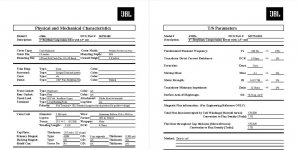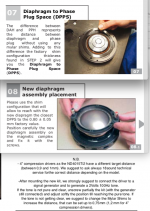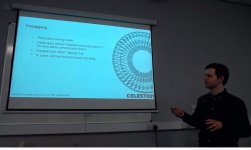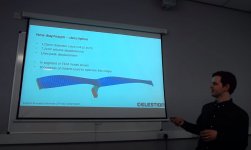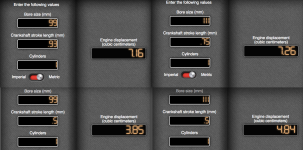GM I like how you sit in the shadows waiting for a point in the discussion worth your time 😉 you've been like a guardian angel through out this project.
The bi-radials I spoke of (made by Docali), I just made the connection that they are reminiscent of the Altecs...I hope he shares his Bi-Radial JMLC when its finished😀
Now that I can estimate excursion, combined with my theory that smaller horns can be used below cutoff....I can potentially model towards an even smaller horn that will potentially allow me to crossover at 350hz. The counter balance is the loss of directivity...So I still love the big horns, but in the thought of experimentation, I can make educated guesses before making a move. Also, Docali has shown the ability to model horns that can maintin a width while adjusting the fc...so with that in mind, directivity by width can be maintained!
It is completely disrespectful that manufactures are not sharing the thiele specs needed to model by excursion at the very least!!!! I've been blessed with the sd and xmax figures for my driver but there are how many other compression drivers that you guys love that you have no idea what the SD and xmax are !?!?!😡😡😡
To clarify some things. These are neither biradial horns nor JMLCs. I would call them natural exapansion horns and the procedure is inspired by JMLC.
I will not share them as ply.
A nominal 4” diaphragm has about 12.2 square inches of diaphragm area, Sd 78.54 sq cm for a JBL 4”.It appears, that the Axi can run to 300hz with only a waveguide, more or less...I'm guessing that 1mm of excursion is more than other compression drivers, considering the depth of performance, with a diaphragm that has less surface area than a 4" diaphragm or am I mistaken on my assumption the surface area of a 4" diaphragm.
Can anyone confirm the sd of a popular 4" compression driver diaphragm? how about the xmax?
HF drivers are by design displacement limited to around 1mm, or the HF rolloff caused by the acoustical bandpass created by the volume of air between the diaphragm and the phase plug reduces HF extension too much to be useful past 10kHz or so.
With excursions approaching 1mm, the diaphragm hammers against the phase plug, which sounds very bad, though the magnetic system could still be linear at that excursion.
Though JBL lists the Xmax of the 476 Be at .5mm, the actual diaphragm to phase plug gap is probably very close to 1mm.
18 Sound includes the Diaphragm to Phase Plug Space (DPPS) in their diaphragm replacement guide, the smaller diaphragms .8mm DPPS, 4” target DPPS at .9 to 1mm.
As Dr Jack Oclee-Brown mentioned in
YouTube
the displacement of the AXi2050 is about the equivalent to that of a 4” dome,
the AXi2050, being an annular diaphragm, has an excursion of 1mm near the voice coil, “coming down to almost nothing at the surround”.
The AXi2050 has less low frequency (below 600 Hz) second harmonic distortion from mechanical limiting of the suspension the (presumably BMS) dual diaphragm driver he compared it to has.
As he also mentioned, “it’s not so good at high frequencies..”
The AXi2050 lack of mechanical limiting will also allow the diaphragm to hammer against the phase plug with less voltage applied ;^).
Art
Attachments
Weltersys - I know you know alot more about this stuff than I, I have some questions.

The video says 5-1/4" displacement not 4"
The modelling that I've tried to do, what do I need to do to make it more accurate? Based off of this formula 7.2 cm^3:0.1 cm=72 cm^2....I've used it for the SD...Taking 72 cm^2 as opposed to 5-1/4" displacement can we formulate a more accurate Xmax? The guy says the diagram can move 1mm in either direction linearly in the video so how are we judging this to be inaccurate..
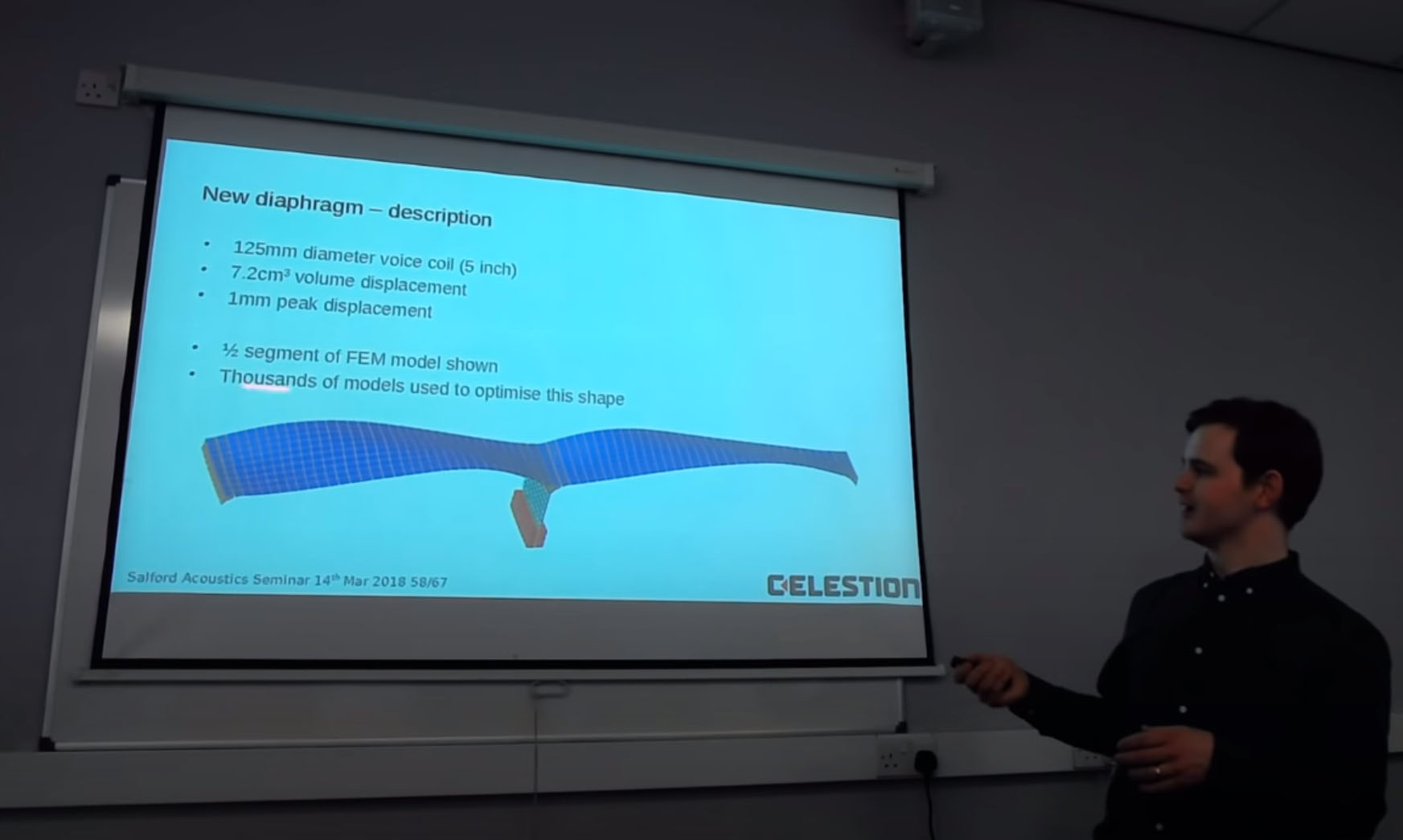
The video says 5-1/4" displacement not 4"
&The AXi2050 has less low frequency (below 600 Hz) second harmonic distortion from mechanical limiting
This is confusing me....The AXi2050 lack of mechanical limiting will also allow the diaphragm
The modelling that I've tried to do, what do I need to do to make it more accurate? Based off of this formula 7.2 cm^3:0.1 cm=72 cm^2....I've used it for the SD...Taking 72 cm^2 as opposed to 5-1/4" displacement can we formulate a more accurate Xmax? The guy says the diagram can move 1mm in either direction linearly in the video so how are we judging this to be inaccurate..
Attachments
Last edited:
What you See in that slide is not Sd in cm^2 but Vd in cm^3.
Regards
Charles
Yes, and someone translated the vd into sd for me...is the translation inaccurate?
Vd = Sd x Displacement
7.2cm3 / 0.1cm = 72cm2
If Vd = 7.2cm3 and Displacement is 0.1cm (1mm) then Sd is 72cm2
7.2cm3 / 0.1cm = 72cm2
If Vd = 7.2cm3 and Displacement is 0.1cm (1mm) then Sd is 72cm2
No - it is not !
If it uses pistonic motion then your calculation is right.
But the driver in question doesn't use pistonic motion becaue it doesn't have a suspension. So the Vd is closer to the volume of either a cone or a pyramid whose volumes are one third of the height multiplied by their bottom area.
Regards
Charles
If it uses pistonic motion then your calculation is right.
But the driver in question doesn't use pistonic motion becaue it doesn't have a suspension. So the Vd is closer to the volume of either a cone or a pyramid whose volumes are one third of the height multiplied by their bottom area.
Regards
Charles
I have not seen that mentioned before do you happen to have a reference where that is explained?
As Dr Jack Oclee-Brown mentioned in
YouTube
the displacement of the AXi2050 is about the equivalent to that of a 4” dome,
the AXi2050, being an annular diaphragm, has an excursion of 1mm near the voice coil, “coming down to almost nothing at the surround”.
Leads me to this assumption.
Regards
Charles
I've just tried a measurement at 50cm from a 240Hz JLMC Horn with a JBL2450SL.
This horn goes perfectly as low as 225Hz 0db with BMS coax
Crossovers of the 2450SL is set at 200Hz LR24 (risky) to see
Sorry but I left my subwoofers (3X15" + 1XB&C18TBW100 Keystone TH) the room was vibrating with this level (see distorsion...).
I left little EQ (450Hz, 800Hz, 6KHz) and 7.2KHz crossover.
The level is very high for home use.
Usually this 2450SL is crossed at 400Hz (party mode).
We can see that JBL 4" CD with a good horn can goes as low as 300Hz with good level and without distorsion.

This horn measures 65cmX65cmX55cm (26"X26"X22")
Then if a JBL 4" can go as low as 300Hz I think that there will have no problem with Axi (as BMS coax)...With the good horn.
The real issue would be smooth directivity and treble quality...
This horn goes perfectly as low as 225Hz 0db with BMS coax
Crossovers of the 2450SL is set at 200Hz LR24 (risky) to see
Sorry but I left my subwoofers (3X15" + 1XB&C18TBW100 Keystone TH) the room was vibrating with this level (see distorsion...).
I left little EQ (450Hz, 800Hz, 6KHz) and 7.2KHz crossover.
The level is very high for home use.
Usually this 2450SL is crossed at 400Hz (party mode).
We can see that JBL 4" CD with a good horn can goes as low as 300Hz with good level and without distorsion.

This horn measures 65cmX65cmX55cm (26"X26"X22")
Then if a JBL 4" can go as low as 300Hz I think that there will have no problem with Axi (as BMS coax)...With the good horn.
The real issue would be smooth directivity and treble quality...
Last edited:
I've just tried a measurement at 50cm from a 240Hz JLMC Horn with a JBL2450SL.
This horn goes perfectly as low as 225Hz 0db with BMS coax
Crossovers of the 2450SL is set at 200Hz LR24 (risky) to see
Sorry but I left my subwoofers (3X15" + 1XB&C18TBW100 Keystone TH) the room was vibrating with this level (see distorsion...).
I left little EQ (450Hz, 800Hz, 6KHz) and 7.2KHz crossover.
The level is very high for home use.
Usually this 2450SL is crossed at 400Hz (party mode).
We can see that JBL 4" CD with a good horn can goes as low as 300Hz with good level and without distorsion.

This horn measures 65cmX65cmX55cm (26"X26"X22")
Then if a JBL 4" can go as low as 300Hz I think that there will have no problem with Axi (as BMS coax)...With the good horn.
The real issue would be smooth directivity and treble quality...
Probably the most interesting info in the thread
20 years ago I was one of the first to measure BMS coax
With old pc, ecm8000 micro, cool edit, only the medium of the BMS (with lot of noise floor...), the same 240hz jmlc horn, 150hz xover to protect the CD

My old website explained the build : CONSTRUCTION DU PAVILLON 60*60
With old pc, ecm8000 micro, cool edit, only the medium of the BMS (with lot of noise floor...), the same 240hz jmlc horn, 150hz xover to protect the CD

My old website explained the build : CONSTRUCTION DU PAVILLON 60*60
I guess I should probably question you on the tonal quality, I’ve been told that running a full range on a 200hz horn sounds like a megaphone...the idea was that the 350hz tuning and higher would be more suitable for a full/wide range type driver...polar wise and tone wise...
We’ve seen a couple of people leave the axi for a Be driver, wonder if the trend will carry over
We’ve seen a couple of people leave the axi for a Be driver, wonder if the trend will carry over
Last edited:
I guess I should probably question you on the tonal quality, I’ve been told that running a full range on a 200hz horn sounds like a megaphone...the idea was that the 350hz tuning and higher would be more suitable for a full/wide range type driver...polar wise and tone wise...
We’ve seen a couple of people leave the axi for a Be driver, wonder if the trend will carry over
People on internet like to repeat what they read. And what they read is from someone who's read this thing from someone else who's read it from someone who want to explain that he is the only to have the good solution because he's proud of what he realised. etc. (ego issue!) I's why there are autosuggestion, autopersuasion and myths... e're humans.
If it's a good horn it won't sound like a Megaphone, BUT what I tried to explained you with drawings (because my english is bad) is that the subjective feelings differences between horns (good ones) can be explained with response on axis AND of axis.
On axis, try to increase 300hz aera you will have tunnel song, 1khz you'll have honk, 2khz presence (you'll be closer to the instrument), 3-5khz shine and tiring, 6Khz sibilance, 9Khz sparkle etc. Only one or 2db changes the sound...
But you must ad of axis response because your brain perceive a mix between on and of axis response. Concerning on axis response the target is easy (flat or with personal EQ...) but for of axis we don't know what's the target. We can't say if the good of axis response is like constant directivty or more sloping (like power/in room response) ... It depends on records, room etc. There is lot of debate on this point! But the only thing we're sure is that of axis response should be smooth. If a horn has of axis response with a small slope from its cut of (ie 200Hz) to 1KHz and then at once the slope begin more important from 1Khz to 20KHz, your brain will perceive that the 800Hz-1KHz aera is more energized, more "big" (image), and more honk honk.
It's the megaphone...
You can have a tunnel sound with a big mid bass horn, or (very classic situation) an agressive sound with a horn on which directivty rise abruptly from 4 or 5khz (2-3khz will be perceived omni present).
One more time my english is limited but I hope you understand what I mean.
With good and big horn on "big CD", you'll have small and smooth directivty on voices aera, perhaps you'll feel that voices are more live (because you feel closer...I personaly love that) than the reality, but the more you'll go high the more you loose this effect...It's why "we" consider that JMLC profile should be limited to more or less 4 octaves (or used with tweeter...or accept the compromise to not have sparkles trebles -for classical music that's ok). Constant directivity horn (good one like oswg!) could be the opposite, you loose some quality of jlmc horn but you gain something else (more frequency balanced of axis then perceived by you brain more relaxed sound).
The theory and the advices of others forumers (what they read for some but lots of experience from others...with a mix of ego...) are interesting but the more important is what do you want? The compromise you prefer? What sort of listenning experience do you like? neutrality, coherence, warmth, lively but sometime agressive if the record is, big and spatial image, close or far listenning, subrealistic, realistic or overrealistic etc!.?
I know that lots of people who read this would like to say that it's **** and that all perfectly flat equalized systems soud the same but f..k to there ego...
I hope you feel what I mean (I work my english) 😉
1)At 50:38 while the screen says the New Diaphragm has a 125mm diameter voice coil with 7.2 cc volume displacement and 1mm peak displacement, he verbally says that is "equivalent to a very, very big dome, it's I think equivalent to around about a 4" dome diaphragm, so it can move a lot of air".1)The video says 5-1/4" displacement not 4"
2)The guy says the diagram can move 1mm in either direction linearly in the video so how are we judging this to be inaccurate..
Domes have a suspension that allows the entire dome to move as a piston, while an annular diaphragm the center can move X distance (about 1mm) while the two outer edges are "pinned", no movement. No simple equation will actually figure it's displacement, even if the Sd and excursion are known, though for Hornresp, you could just as well figure a 4" dome at 1mm excursion..
The 7.2cc displacement claimed for the Axi2050 would be the equivalent of a 99mm (4") dome (piston) moving about .93mm, which sounds reasonable, as that is a bit under the full 1 way excursion possible for a typical 4" diaphragm before the diaphragm hits the phase plug.
Going to a 111mm (5.25") at .75mm stroke gives a similar displacement, though I don't know of any dome diaphragms of that size.
At any rate, a single diaphragm producing 300 to 20kHz at full excursion won't sound as good as it would if excursion was reduced to a fraction of that by raising the crossover an octave, or splitting the range between two diaphragms.
Art
Attachments
People on internet like to repeat what they read. And what they read is from someone who's read this thing from someone else who's read it from someone who want to explain that he is the only to have the good solution because he's proud of what he realised. etc. (ego issue!) I's why there are autosuggestion, autopersuasion and myths... e're humans.
If it's a good horn it won't sound like a Megaphone, BUT what I tried to explained you with drawings (because my english is bad) is that the subjective feelings differences between horns (good ones) can be explained with response on axis AND of axis.
On axis, try to increase 300hz aera you will have tunnel song, 1khz you'll have honk, 2khz presence (you'll be closer to the instrument), 3-5khz shine and tiring, 6Khz sibilance, 9Khz sparkle etc. Only one or 2db changes the sound...
But you must ad of axis response because your brain perceive a mix between on and of axis response. Concerning on axis response the target is easy (flat or with personal EQ...) but for of axis we don't know what's the target. We can't say if the good of axis response is like constant directivty or more sloping (like power/in room response) ... It depends on records, room etc. There is lot of debate on this point! But the only thing we're sure is that of axis response should be smooth. If a horn has of axis response with a small slope from its cut of (ie 200Hz) to 1KHz and then at once the slope begin more important from 1Khz to 20KHz, your brain will perceive that the 800Hz-1KHz aera is more energized, more "big" (image), and more honk honk.
It's the megaphone...
You can have a tunnel sound with a big mid bass horn, or (very classic situation) an agressive sound with a horn on which directivty rise abruptly from 4 or 5khz (2-3khz will be perceived omni present).
One more time my english is limited but I hope you understand what I mean.
With good and big horn on "big CD", you'll have small and smooth directivty on voices aera, perhaps you'll feel that voices are more live (because you feel closer...I personaly love that) than the reality, but the more you'll go high the more you loose this effect...It's why "we" consider that JMLC profile should be limited to more or less 4 octaves (or used with tweeter...or accept the compromise to not have sparkles trebles -for classical music that's ok). Constant directivity horn (good one like oswg!) could be the opposite, you loose some quality of jlmc horn but you gain something else (more frequency balanced of axis then perceived by you brain more relaxed sound).
The theory and the advices of others forumers (what they read for some but lots of experience from others...with a mix of ego...) are interesting but the more important is what do you want? The compromise you prefer? What sort of listenning experience do you like? neutrality, coherence, warmth, lively but sometime agressive if the record is, big and spatial image, close or far listenning, subrealistic, realistic or overrealistic etc!.?
I know that lots of people who read this would like to say that it's **** and that all perfectly flat equalized systems soud the same but f..k to there ego...
I hope you feel what I mean (I work my english) 😉
One of the very best posts I've read in a while, thank you !🙂
- Home
- Loudspeakers
- Multi-Way
- Is it possible to cover the whole spectrum, high SPL, low distortion with a 2-way?
